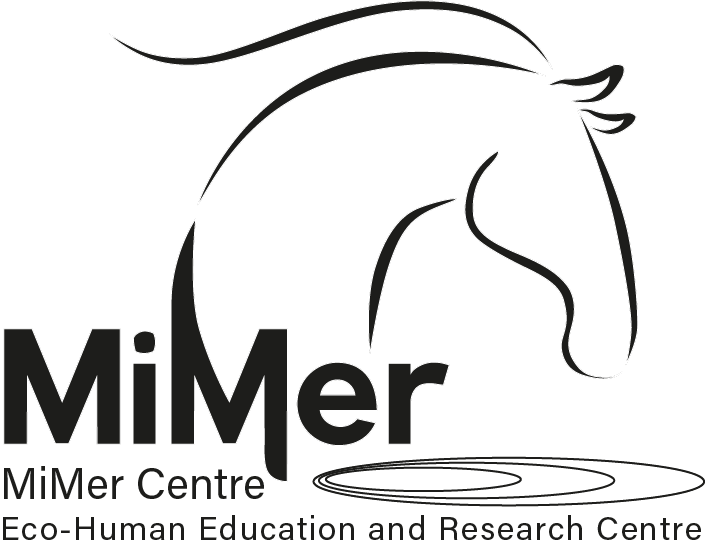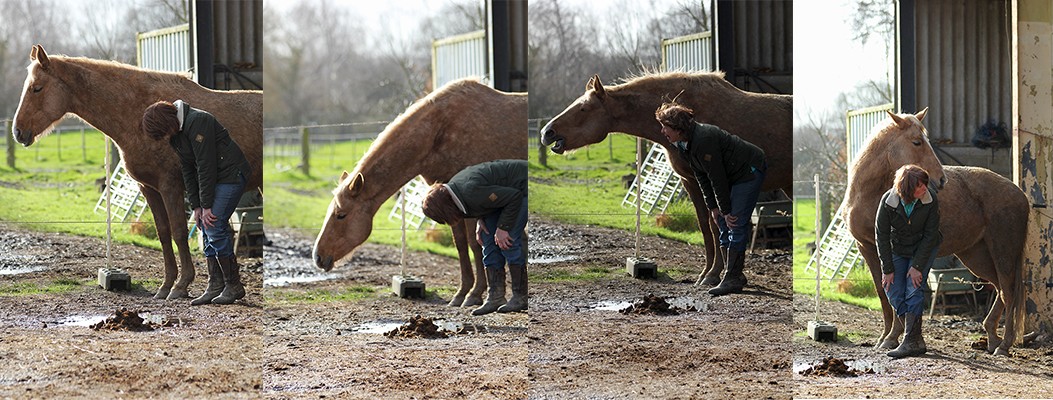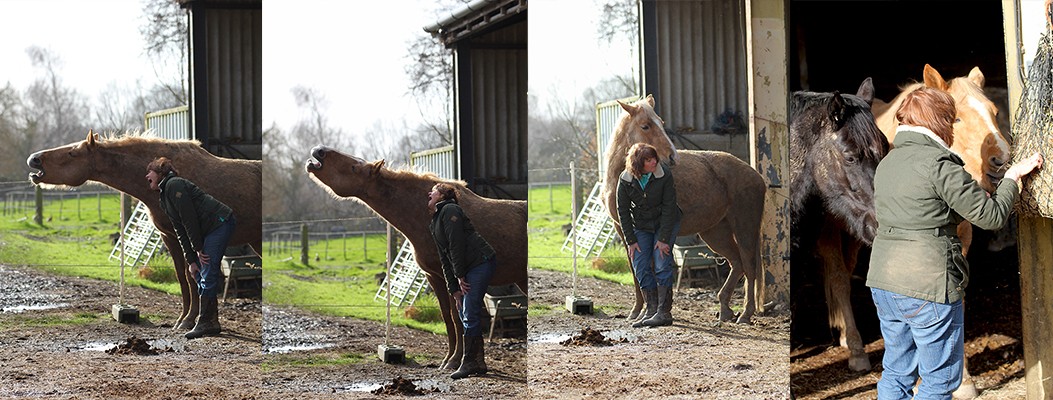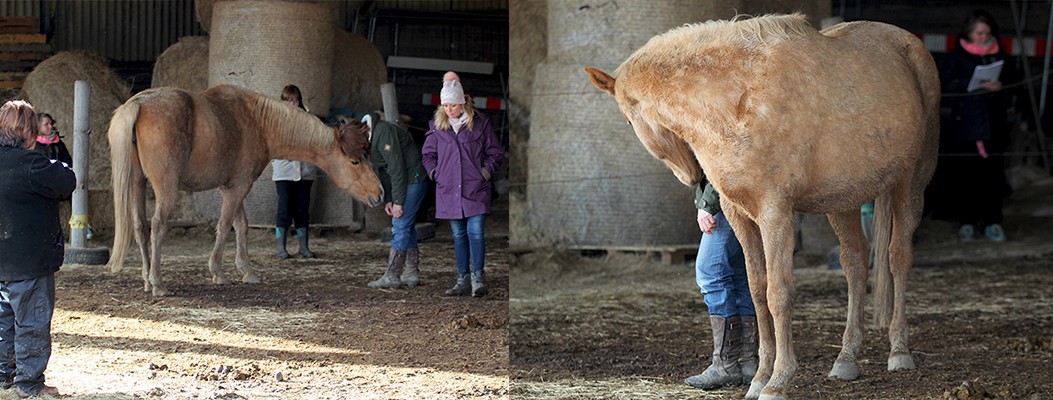The Imitation Game...
During our EiT/L training in Kent a week ago – I was privileged to see something I knew existed – but never before so obviously have presented itself before my eyes – when I had a camera in my hand and was in an observing role. Now I had the opportunity to see the whole interaction play out and take photos of it. It felt like someone had given me a precious gift!
I was watching a horse during those moments she understood a human was imitating her. It was fascinating to follow the exchange of communication between them. How the horse first wondered what was going on, then had the though (a hypothesis!) – and then tested it – several times. Then concluded she was right – and went on to engage in it fully. It went from being an imitation game to an explorative communication game and a social dance.At first the horse, named Apple, was standing dozing. Michelle (the human) positioned herself besides Apple. Michelle started to imitate Apple – as good as a human can do that. In the beginning the movements were slow – Apple continued to doze. Michelle had a lot of patience and later told me she went into this interaction without any expectations. She just wanted to try something new out. This was after we had had theoretical discussions about how a common ground of communication is generally established (we had talked about the chameleon effect, how humans create a common ground by unconsciously imitating each other – which leads to a higher liking of each other, I had told about how I play (and "talk like that") with horses (or other non-verbal beings, dogs, babies…), we had discussed research on this in humans, human infants and other primates). So, she just wanted to see what could happen if she tried this out.
Apple was of course aware of Michelle's presence all the time. She did small movements, adjustments of limb position, shifting weight, flickering with her ears, blinking, moving her muzzle – showing all kinds of micro-behaviors, even when she dozed. At some point she picked up that whatever she did was followed by a small movement from Michelle. When she had picked that up, Apple started to do bigger movements – and Michelle continued to imitate her. She lifted her hoofs, yawned a lot, did bigger movements, like turning her head (there is quite a lot research on contagious yawning, especially in primates, but also some on dogs – yawning is shown to be contagious on a cross-species level, there is even research claiming contagious yawning is coupled to how we learn empathy). Michelle kept on imitating. And I kept on watching Apple as she first seemed to realize that Michelle was imitating her, to where she started to test that by doing all kinds of movements and behaviors. She soon picked up on that she somehow seemed to guide this human's movements. And then she really started to play with it! They moved around together, ate together – at some point it left imitation and went into exploration and exchange – the movements in Michelle became freer, less imitative and more following – until the end where they seemed more to engage in a dance. The whole sequence took maybe 20 minutes and was very cool to observe. I am sharing some of the photos I took. They won't tell you everything but will give you an idea of what went on.
When I was thinking of trying to write something about this, I came to think about "the imitation game". Turing, the man who basically invented computers, wrote a paper in the 50-ties asking the question if there would ever be a machine that could think. A way to test that would be for the machine to pass his "imitation game" or later also called the Turing test. The question was if a machine ever would be able to imitate human answers to questions posed by humans, to fool the human to think the machine is a human (if the human couldn't see it).
Maybe the imitation game is not about AI – as in Artificial Intelligence? Maybe it could instead be AI as in (non-human) Animal Intelligence? Maybe – if we take the verbal part away – we would discover that a wide variety of non-human animals are so much smarter than we ever could imagine (by the way – I can recommend Frans de Waal's book – Are we smart enough to know how smart animals are? To ponder that question some more…)
What I saw was a highly complex interaction between a horse and a human – who left the ordinary scripts of how horse-human interaction "should" be done. One can always claim I imagined what I saw. Maybe I did. I don't think so. I have seen it before. And I have tested it myself. And considering probably all mammals use imitation in similar ways – it makes sense that horses too use imitation to create a common ground of understanding (will post more about the chameleon effect later). Look at how animals play – there is imitation. Look at how they learn, there is imitation. Look at how they explore – and how they socialize, there is imitation – that turns into reciprocity, social bonding, herd life…
And we do not call horses for mirrors for nothing (even if I do not like the alluding to a dead surface that only reflects, but bring no subjectivity – I prefer imitators)… how we move – is connected to how we think, feel and intentionally act – movement becomes cognition. We are all minds in motion. We all mirror/imitate each other – to first get to know each other, to play, to learn together, to create a common language – to try new things out – and so on. Using imitation is how we enter this world. It is a very, very important tool and is used in many different ways, from establishing communication (as infants/foals – to become highly sophisticated social learners – and create cultures and societies (that are species specific – and maybe our human culture or our societies are more evolved, they still follow the same developments and traits as any culture or society).
It all starts with – I do as you do – and you do as I do… so we start to dance – and learn about each other – it becomes a very focused seeing, sensing each other.
This is the part of behavior studies that intrigues me, not so much the – how to shape behaviors that we want.
Stay Informed
When you subscribe to the blog, we will send you an e-mail when there are new updates on the site so you wouldn't miss them.




Comments